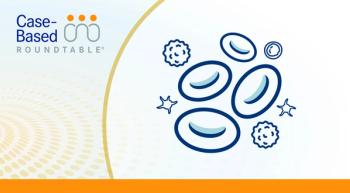
Virtual Tumor Board®: An Overview on Graft-Versus-Host Disease and Prophylaxis
Expert perspectives on the nature and occurrence of graft-versus-host disease alongside available prophylactic regimens.
Episodes in this series

Transcript:
Nelson Chao, MD: Thank you for joining us at the Targeted Oncology Virtual Tumor Board, which is focused on practice updates in graft-versus-host disease [GVHD]. In today’s presentation, my colleagues and I will review 3 clinical cases. We will discuss approaches to treating patients who are at risk or who develop graft-versus-host disease. We will share our perspectives on key clinical trial data that may impact our decisions. I am Dr Nelson Chao from Duke University [Durham, North Carolina]. Today, I am joined by Dr Corey Cutler from Dana-Farber Cancer Institute [Boston, Massachusetts] and Kerry [King] Minor from Duke University. Thank you for joining us.
I would like to start by giving a brief overview of the process for allogeneic transplant. We need to collect donor cells, which could be related or unrelated. The stem cells can be separated from the blood or given as a whole. There is a conditioning, or treatment of the recipient. Chemotherapy and/or radiation will kill the cancer and weaken the donor immune system. The cells are infused to the patient and then we wait for engraftment. Graft-versus-host disease is a leading cause of non-relapse mortality following allogeneic transplantation. In acute GVHD, the reaction of the donor immune cells against host tissues is the ideology of the disease. Three main tissues are affected: the skin, the liver, the gut. In chronic graft-versus-host disease, the syndrome is quite variable with features resembling autoimmune or other immunologic disorders. In chronic GVHD, you could have a single organ, or it might be widespread and have a significant impact on quality of life. The risk factors for acute and chronic are similar, although the greatest impact of chronic is having acute prior. With standard prophylaxis, 25% to 50% of patients receiving HLA [human leukocyte antigen]-matched transplant will develop acute GVHD. That may require high-dose systemic steroids, and up to 50% of patients will have inadequate response to steroid therapy, which is associated with poor prognosis.
So this is a sort of a classical slide down demonstrating the pathology where in number 1, the recipient, who received the conditioning regimen, ends up with tissue damage. Those tissues release inflammatory cytokines such as IL [interleukin]-1 and IL-6, and then there is damage to the small bowel, usually releasing LPS [lipopolysaccharides]. These go down through different pathways, one goes to host antigen-presenting cells, which will activate the donor cells that release IL-12, IFN [interferon-gamma]-γ, and IL-2. Both are within the small bowel because of the LPS, as well as the microbiota entry, and release of those pattern associated damage receptors. There is target cell apoptosis of the gut, which then amplifies the response from the cytotoxic lymphocytes and NK [natural killer] cells together with TNF [tumor necrosis factor]-α and IL-1. So most commonly the GVHD prophylaxis includes calcineurin inhibitors; methotrexate; MMF [mycophenolate mofetil]; sirolimus [Rapamune]; T-cell antibody; Ex vivo T-cell depletion, such as CD34 selection; posttransplant cyclophosphamide; and then obviously the standard combination of tacrolimus and methotrexate. So I’m going to stop here for a second and ask Dr Cutler to give us a sense of where these regimens fall within the Dana-Farber Cancer Institute.
Corey Cutler, MD, MPH, FRCPC: Sure. Thanks for the introduction, Nelson. At our center, the predominant regimen that we use in the mild of greater setting is still the classic combination of tacrolimus and methotrexate. In the reduced intensity setting, we often add in the M200 meter cells. We are using the posttransplant cyclophosphamide regimen whenever we do haploidentical transplants. At the moment, there isn’t compelling data that suggests a superior regimen to tackling the methotrexate. So most of us don’t use it as a matter of routine outside of either the clinical trials or the haploidentical setting.
Nelson Chao, MD: And Ms. Minor, what do you think are the major toxicities that you see with these standard regimens?
Kerry King Minor, MSN, ANP-BC: Well, we always educate the patients that are going to be receiving the methotrexate about the risk of mucositis. That’s probably 1 of the biggest things that we see in patient education with that prophylaxis agent and tacrolimus. We prepare them and monitor very closely for side effects, such as headaches, effects on their blood pressure, effects on their kidneys and their knees. That’s basically it. With cyclophosphamide, typically patients tolerate that fairly well.
Transcript edited for clarity.












































